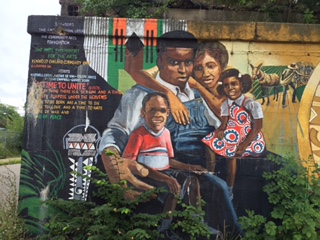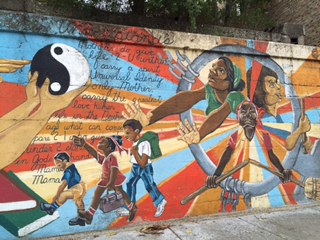Design & Test Prevention Interventions

SAFE Children is a family-focused, school-based preventive intervention designed to aid children and families in the transition to school by increasing children’s reading achievement, encouraging parent involvement in education, and improving parenting practices and family relationships. During weekly sessions, families discuss issues of parenting, family relations, and parental involvement and investment in their child’s schooling.
Duration: 20 weeks
Target population: urban families with elementary-age children
Demonstrated impact: decreased aggression and hyperactivity; increased social competence, parent involvement in school, academic functioning and reading scores, and improved/maintained children’s concentration and pro-social behavior

Schools and Families Educating Children (SAFE Children)
SAFE Children is a family focused, school-based preventive intervention designed to aid children and families in the transition to school by increasing children’s reading achievement, encouraging parent involvement in education, and improving parenting practices and family relationships. Projects for SAFE Children were funded by Center for Substance Abuse Prevention, Substance Abuse and Mental Health Services Administration, National Institute on Drug Abuse, National Institute of Justice (Investigators: Patrick Tolan, Ph.D., Deborah Gorman-Smith, Ph.D., & David Henry, Ph.D.) The target population is low-income, urban families with early elementary age children. This intervention has demonstrated the ability to mediate the impacts of ecological barriers for child development in both academic achievement and parent involvement. SAFE Children has been recognized by SAHMSA’s National Registry of Evidence-Based Programs, National Registry of Effective Programs and Practices, National Gang Center: Effective Program, and an Exemplary Program by the US Department of Justice.
The SAFE Children intervention is comprised of multiple family groups (e.g. about six families per group) where the individual families have been selected by their child’s teachers because he or she is exhibiting aggression or behavior problems in class. Without intervention, these children are at the highest risk for developing violent behavior as they age; it has repeatedly been demonstrated that violence perpetration is strongly associated with early aggression, poor reading skills, and lack of supportive parenting practices. 1-3
During weekly sessions lead by a trained interventionist, families discuss issues of parenting, family relations, and parental involvement and investment in their child’s schooling. Session themes include: Helping Kids Do Their Best in School, Parents as Teachers and Advocates, Communication with Children and Adults, Discipline, Family Rules and Consequences, and Anger and Self-Control. The family group structure has been shown to build social support and improve parent-child interactions, critical factors to generalizing and maintaining positive changes. 4, 5
The ultimate goal of the SAFE Children intervention is to ‘hand-off’ the program to school personnel. Staff from the CCYVP will not only fully train school liaisons in intervention delivery, but also provide on-going technical assistance and assessment of strengths and barriers to implementation quality and fidelity. It is critical that the CCYVP carefully monitor the continuous implementation as there is increasing evidence that intervention effects depend on delivery of programs as designed and planned. 6, 7 Low quality implementation of an “evidence-based” intervention can significantly reduce program effects.8
Throughout the 20 week intervention, the target child receives intensive reading tutoring. The tutoring program initially emphasizes phonics and word recognition and then incrementally builds on these skills by applying them to high-interest reading, relevant material with positive messages, and activities designed to increase parental involvement in their child’s academic development. Additionally, the tutoring curriculum complements the Chicago Public Schools phonics-based reading program, which allows for seamless generalization to the classroom.
SAFE Children has been tested specifically for its effects on high-risk families and was shown to have significant impact on high-risk family’s aggression, hyperactivity, social competence, and parent involvement in school. Taken together, the key components of SAFE Children, reading improvement and parenting skills training, successfully address major risk factors for violence involvement.
Tolan, Gorman-Smith, & Henry (2004) show that the SAFE Children program:
- Decreases child aggression.
- Improves reading scores and academic functioning.
- Maintains parental involvement in their child’s schooling.
- Improves or maintains the child’s concentration and prosocial behavior.
Adaptations:
A modified version of SAFE Children 9, 10 called SAFE Children – Universal, is provided at the school wide level for all children and families entering kindergarten in each of the six schools in the targeted, high risk Chicago community. The intent of the intervention is to help parents gain or apply skills to manage family responsibilities and challenges during and immediately after this important developmental transition. By supporting families, we hope to promote healthy development and reduce risk at the general school level.
International Adaptations: SAFE Children has been adapted and implemented in two international locations:
- Sihleng’imizi is a South African adaption of the SAFE Children Family Program. This is a collaborative project between the University of Johannesburg and the University of Chicago.
- “Families Together” (Bütöv Ailə) is an Azerbaijani adaption of the SAFE Children Family Program. This is a collaborative project between Azerbaijan Social Work Public Union and the University of Chicago.

The GREAT Schools and Families program is designed to reduce school violence by decreasing aggression, promoting children’s academic and social competence, and improving parental skills, support, and involvement with schools. GREAT delivers multiple-family groups and activities that integrate parenting skills, family management, developmental education, and family support to strengthen youth protective factors.
Duration: 15 weeks
Target population: middle school youth & families
Demonstrated impact: decreased aggression and violence exposure; increased parental monitoring, family cohesion and family problem solving
Guiding Responsibility & Expectations in Adolescents Today & Tomorrow (GREAT Schools and Families)
GREAT Schools and Families was a multi-site and multi-school violence prevention initiative funded by Centers for Disease Control and Prevention. Four sites (University of Illinois at Chicago, Virginia Commonwealth University, University of Georgia at Athens, an Duke University) implemented a multi-component intervention designed to address a major scientific question regarding reducing school violence: Are greater reductions in school violence found when a general violence prevention program is implemented with all children in a given grade or when an intervention is targeted at those youth who are at greatest risk for involvement in violence (i.e. those already participating in a high rate of aggressive behavior)or are both types of intervention needed?
Programs that have previously shown the greatest promise in reducing youth violence were implemented and are being evaluated. The intervention components are broken down into two approaches: universal and targeted intervention. The universal intervention was implemented with all students in 6th grade. The universal intervention has two components: a social cognitive and problem solving intervention delivered to students; and a teacher training component around the issues of classroom management strategies and building awareness of aggression and victimization in the classrooms. The targeted intervention focused on those students who are at high risk for violence and includes a family intervention delivered in multiple family groups and a school-monitoring component. 12 Chicago Public Schools were randomized into 4 groups: 1) 4 schools receiving the universal intervention; 2) 4 schools receiving the targeted treatment; 3) 4 schools receiving both treatments; and 4) 4 comparison schools.
